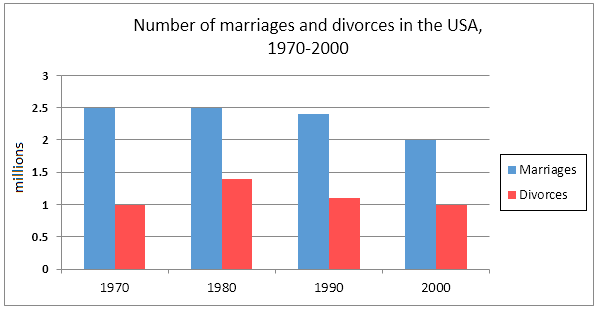
IELTS Writing Task 1 Analysis (Marriage and Divorce Rates) – Band 6.5
Let us do complete analysis of IELTS writing task 1 submitted by one of the candidates.

Candidate’s Response:
The bar chart illustrate, the information about marriage and divorce rates in USA and American adult marriage status in over three decades, from 1970 to 2000.
To begin with, it can be seen that, the rate of marriages experienced significant drop in the given time period. Even though the rate was constant for two years 1970 and 1980 (2.5 millions), but it witnessed significant decline in further two years 1980 (just over 2 million) and in 2000 exactly 2 million marriages. But divorces rate is showing quite different trend. In 1970, the divorce rate was 1 million and it increased slightly to just under 1.5 million. But the figure again reached to same point that where it started in 2000 (1 million).
While, as far as material status of American adult is concerned, in both 1970 and 2000, adult’s marriage percentage is higher than other three material statuses. But the percentage in 1970 is quite higher than the marriage percentage in 2000. Interestingly, the year 2000 experienced more proportion of divorced adults than 1970, which is neary double. That is just over 3% 1970 to 6% in 2000. While the statuses never married and widowed adults proportions are almost same with slight differences.
In conclusion, Even though marriages rate decreased over the period, they are more higher than the divorce rate in USA. While, in the same way except slight drop in 2000, American adults married in more proportion in both the years.
We will be doing analysis of the above IELTS writing task 1 response as below:
Para 1
Strength:
Main feature of the question is written well along with factual information.
Corrected Erroneous Statement:
“bar chart illustrate, the information” should be “bar chart illustrates the information”, “divorce rates in USA” should be “divorce rates in the USA”, “in over three decades” can be “in over the three decades”
Para 2
Strength:
Sentence connector (to begin with) is used, main key features are explained along with factual information and complex sentences are attempted.
Corrected Erroneous Statement:
“Even though the rate was constant for two years 1970 and 1980 (2.5 millions), but it witnessed significant decline in further two years 1980 (just over 2 million) and in 2000 exactly 2 million marriages.” should be “Even though the rate was constant for two years, 1970 and 1980 (2.5 millions), but it witnessed significant decline in the further two years, 1980 (just over 2 million) and 2000 (2 million marriages).”, “to same point that where it started” should be “to the same point where it started”
Para 3
Strength:
Main key features are again explained well with the given figures, complex structure sentences are attempted and there’s good use of connector “interestingly”
Corrected Erroneous Statement:
“While, as far as” can be “While as far as”, “neary double. That is just” should be “neary double, that is, just”, “While the statuses never married and widowed adults proportions are almost same with slight differences”, “while the statuses of never married and widowed adults proportions are almost the same with slight differences”
Para 4
Strength:
Main conclusive feature is described well.
Corrected Erroneous Statement:
“Even though” should be “even though”, “divorce rate” should be “divorces rate”, “in USA” should be “in the USA”, “While, in the same way except slight drop in 2000, American adults married in more proportion in both the years” should be “while, in the same way except slight drop in 2000, more proportion of American adults were married in both the years”
Expected Band Score: 6.5 Band
The candidate has explained all the main key features with good usage of connectives. However, there are errors in complex structures, grammar, capitalization and others.




